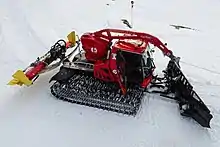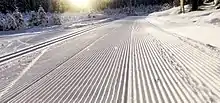Snow grooming
Snow grooming is the process of manipulating snow for recreational uses with a tractor, snowmobile, piste caterpillar, truck or snowcat towing specialized equipment. The process is used to maintain ski hills, cross-country ski trails and snowmobile trails by grooming (moving, flattening, rototilling, or compacting) the snow on them. A snow groomer is usually employed to pack snow and improve skiing and snowboarding and snowmobile trail conditions. The resulting pattern on the snow is known as corduroy,[1] and is widely regarded as a good surface on which to ski or ride. Snow groomers can also move accumulated snow made by snow machines as part of a process, called "snow farming".



Snow groomer
A snow groomer (informally called a "piste basher" in the United Kingdom)[2][3] is a tracked vehicle equipped in front with a shovel (or dozer blade) and behind with a cutter (or roller). It is usually driven by diesel engines. When the machine drives over a snowfield, it pushes snow ahead of it and, at the same time, smooths out any surface unevenness.
Snow groomers built for ski slopes employ front mounted, hydraulically operated blades, powered rotary tillers and specialized shaping equipment for not only maintaining ski slopes, but also for building half pipes, ski/snowboard terrain parks and snow tube parks. Cross-country skiing trails are also groomed in similar fashion, often with a wide "corduroy" area that allows skate-skiing plus classic ski tracks, imprinted with specialized ski guides.[4] Manufacturers include Formatic, Kässbohrer Geländefahrzeug, Prinoth, Ratrak, Logan Machine Company, Tucker Sno-Cat, Snow Trac, Thiokol, the Ohara Corporation (Japan) and Aztec, SAS (France).
Snow groomers can handle very steep gradients due to their low centre of gravity and large contact area, but they can also be assisted by winches. Using cable lengths of up to 1,200 metres and a tractive force of up to 4.8 tonnes, winches can support the machines on steep slopes.[5]
Snow groomers warn skiers and snowboarders with visual or acoustic signals. Groomers are mostly sent out during the night time after the close of the ski area so as not to interfere with daily and night skiing.[6]
Due to their mobility and low ground pressure (typically 0.040 to 0.060 kg/cm2 (about 4 to 6 kN/m2) snow groomers are sometimes used elsewhere, e.g. for agricultural purposes, moving bulk goods, working on peat bogs or at biogas sites.[7]
Snow farming
Snow farming is the use of obstacles, equipment and knowledge about management of snow in order to strategically manipulate snow coverage. Often this is done for the purpose of skiing or even preventing snow drift in certain areas like roads. The most popular obstacle is the snow fence, which is used to create drifts and collect more snow in a given area than would otherwise naturally occur. The snow can be moved to other areas and groomed with the use of a snow groomer. Sometimes the snow fence is readily movable in order to maximize the collection of blown snow, despite wind direction changes.[8][9] In Mora, Minnesota, the annual Vasaloppet cross-country ski race would be unable to happen without the use of snow farming due to lack of natural snow in recent years.[10]
References
| Wikimedia Commons has media related to Snow groomer. |
- Lockwood, Auguste, Corduroy for Groomed Trails, retrieved 2020-10-04
- Editors (2019). "Piste basher". Cambridge English Dictionary. Retrieved 2019-07-26.CS1 maint: extra text: authors list (link)
- Martin, Iain (2018-10-02). "Meet the world's first wheelchair-bound piste basher driver fulfilling his childhood dream". The Telegraph. ISSN 0307-1235. Retrieved 2019-08-19.
- Older, Jules (1998). Cross-Country Skiing for Everyone. Stackpole Books. p. 87. ISBN 9780811727082.
snow grooming.
- Neue Windentechnologie für steilste Hänge (Sherpa-Winde, Prinoth) ISR Internationale Seilbahn-Rundschau 22 April 2011, retrieved 5 September 2014
- Snowmakers, snowmaking prevail when Mother Nature is uncooperative Archived 2007-10-08 at the Wayback Machine - Pocahontas Times - Mountain Times, Vol. 6 No. 2 February 2007
- Pistenraupen zum Bewegen von Hackgut TEST Pistenraupe Prinoth LH 500, Anwender: Thermo Wipptal AG, ([photos dated 15 June 2011), retrieved 5 September 2014
- Agrawala, Shardul (2007), Climate Change in the European Alps Adapting Winter Tourism and Natural Hazards Management: Adapting Winter Tourism and Natural Hazards Management, Environment & Sustainable Development, Paris: OECD Publishing, p. 136, ISBN 9789264031692
- Nelson, Janet (February 1973), "Groom Boom", Ski Magazine, p. 47, retrieved 2017-05-09
- "In Northern Minnesota, 'Snow Farmers' Make Sure A Ski-Racing Tradition Endures". NPR.org. Retrieved 2019-02-11.